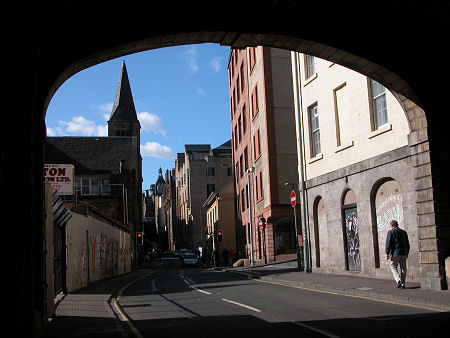 Edinburgh's Cowgate |
James Connolly (Séamas Ó Conghaile) lived from 5 June 1868 to 12 May 1916. He was an Irish socialist and republican executed by the British for his part in the Easter Rising in 1916. The wider picture in Scotland at the time is set out in our Historical Timeline.
James Connolly was the son of an Irish immigrant family living at 107 Cowgate in Edinburgh, an area which at the time was home to a large Irish community. His father worked at night as a manure carter, keeping the city streets clean, and his mother was a domestic servant. James and his two brothers attended St Patrick's School in the Cowgate. Connolly left school at the age of 10 and worked for the Edinburgh Evening News as a printers' devil, cleaning ink off rollers and running errands for the printers. At the age of 14 in 1882 he joined the army. He served for seven years, mostly in Ireland, an experience which left him with a deep dislike of British policies in Ireland and especially of the role of the British Army in Ireland.
In 1889, Connolly left the army and settled in Dundee, where he took an active interest in socialist politics and trades union rights. The following year he married Lillie Reynolds, an Irish protestant he had met while serving with the army in Ireland. They subsequently moved to Edinburgh and had several children. In 1893 Connolly became involved in Keir Hardie's Independent Labour Party, and in 1895 he moved to Dublin to become secretary of the Dublin Socialist Society, which he soon changed into the Irish Socialist Republican Party. He continued to play a role in socialist politics in Britain, and in the early 1900s also spent some years in the USA where he joined a number of socialist organisations.
Back in Ireland, Connolly founded the Irish Labour Party in 1912, and took a post with the Irish Transport and General Workers Union. When the Dublin Lockout began over workers' right to join unions in August 1913, Connolly was one of the founders of the Irish Citizen Army, a paramilitary organisation whose role was initially to defend strikers from the police, though it soon expanded to include the creation of an independent and socialist Irish nation.
The Irish Citizen Army was only one of a number of groups in Ireland at the time who were pressing for Irish Independence from Britain. Others included the well established Irish Volunteers, a relatively moderate group who were concerned to ensure home rule for Ireland, and the highly secretive and much more hard line Irish Republican Brotherhood, whose aim was nothing less than the establishment of an independent democratic Republic of Ireland. In early 1916, Connolly tried to spur the Irish Volunteers into more decisive and urgent action, unaware that the Irish Republican Brotherhood were already planning an uprising. The IRB leadership met with Connolly (some say they kidnapped him) and it was agreed that the IRB and the Irish Citizen Army should coordinate an uprising against the British.
The Easter Rising started on 24 April 1916. James Connolly was Commandant General of the Dublin Brigade, which effectively made him the senior military commander on the Republican side. The rising was suppressed after six days of heavy fighting, much of it in Dublin. Connolly had been seriously wounded during the fighting, and on 12 May 1916 was taken by military ambulance to Kilmainham Jail, where he was tied to a chair and shot by a British firing squad, one of 15 Republicans executed for their part in the uprising. The British response to the uprising was poorly received by public opinion in the United States, and many believe that by creating martyrs the British only hardened the will of republicans in Ireland. James Connolly is commemorated by a statue in Dublin, and in the name of Dublin Connolly railway station and Connolly Hospital in Dublin.

